Neutrosophic method for recommending the use of molecular cocktails in the beverage industry in the city of Ambato
Main Article Content
Abstract
In this research, a neutrosophic method is developed for the recommendation of the use of molecular cocktails in the beverage industry of the city of Ambato; given that new trends in the world of gastronomy, and particularly cocktails, demonstrate how much has evolved in relation to the creative or avant-garde currents of contemporaneity. It is now natural that mixology is discussed among bartenders as the most in-depth study of the art of mixing drinks. We can also know mixology as cocktails. Mixology is generally accepted as a more refined term and a more in-depth study of the art of mixing drinks. Mixology has become a more commonly used term in recent years and is generally used to refer to a higher degree of study of mixing cocktails and drinks than simply doing the daily actions of a bartender. This learning process is not about creating a confrontation to find out who is better, a bartender or a mixologist, but about adding skills to the profession to offer a higher quality service. Mixology transcends work behind a bar. This art or science has achieved amazing results from which novel flavors stand out, trying the combination of distillates with herbs, red fruits or some exotic ingredient or unknown mixers.
Downloads
Article Details

This work is licensed under a Creative Commons Attribution 4.0 International License.

